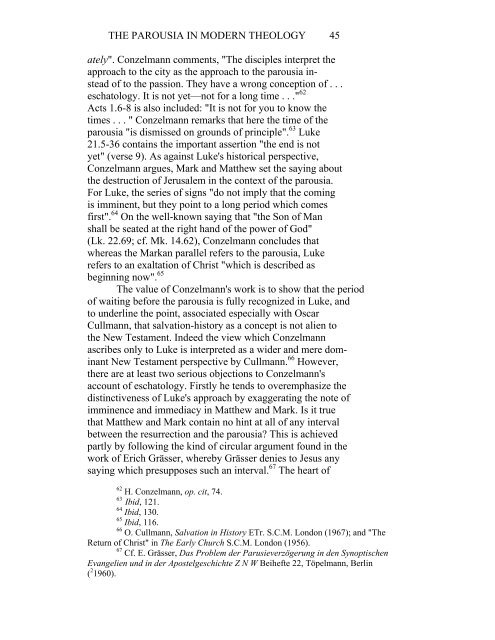the parousia in modern theology: some questions ... - Tyndale House
the parousia in modern theology: some questions ... - Tyndale House
the parousia in modern theology: some questions ... - Tyndale House
Create successful ePaper yourself
Turn your PDF publications into a flip-book with our unique Google optimized e-Paper software.
THE PAROUSIA IN MODERN THEOLOGY 45<br />
ately". Conzelmann comments, "The disciples <strong>in</strong>terpret <strong>the</strong><br />
approach to <strong>the</strong> city as <strong>the</strong> approach to <strong>the</strong> <strong>parousia</strong> <strong>in</strong>-<br />
stead of to <strong>the</strong> passion. They have a wrong conception of . . .<br />
eschatology. It is not yet—not for a long time . . ." 62<br />
Acts 1.6-8 is also <strong>in</strong>cluded: "It is not for you to know <strong>the</strong><br />
times . . . " Conzelmann remarks that here <strong>the</strong> time of <strong>the</strong><br />
<strong>parousia</strong> "is dismissed on grounds of pr<strong>in</strong>ciple". 63 Luke<br />
21.5-36 conta<strong>in</strong>s <strong>the</strong> important assertion "<strong>the</strong> end is not<br />
yet" (verse 9). As aga<strong>in</strong>st Luke's historical perspective,<br />
Conzelmann argues, Mark and Mat<strong>the</strong>w set <strong>the</strong> say<strong>in</strong>g about<br />
<strong>the</strong> destruction of Jerusalem <strong>in</strong> <strong>the</strong> context of <strong>the</strong> <strong>parousia</strong>.<br />
For Luke, <strong>the</strong> series of signs "do not imply that <strong>the</strong> com<strong>in</strong>g<br />
is imm<strong>in</strong>ent, but <strong>the</strong>y po<strong>in</strong>t to a long period which comes<br />
first". 64 On <strong>the</strong> well-known say<strong>in</strong>g that "<strong>the</strong> Son of Man<br />
shall be seated at <strong>the</strong> right hand of <strong>the</strong> power of God"<br />
(Lk. 22.69; cf. Mk. 14.62), Conzelmann concludes that<br />
whereas <strong>the</strong> Markan parallel refers to <strong>the</strong> <strong>parousia</strong>, Luke<br />
refers to an exaltation of Christ "which is described as<br />
beg<strong>in</strong>n<strong>in</strong>g now". 65<br />
The value of Conzelmann's work is to show that <strong>the</strong> period<br />
of wait<strong>in</strong>g before <strong>the</strong> <strong>parousia</strong> is fully recognized <strong>in</strong> Luke, and<br />
to underl<strong>in</strong>e <strong>the</strong> po<strong>in</strong>t, associated especially with Oscar<br />
Cullmann, that salvation-history as a concept is not alien to<br />
<strong>the</strong> New Testament. Indeed <strong>the</strong> view which Conzelmann<br />
ascribes only to Luke is <strong>in</strong>terpreted as a wider and mere dom-<br />
<strong>in</strong>ant New Testament perspective by Cullmann. 66 However,<br />
<strong>the</strong>re are at least two serious objections to Conzelmann's<br />
account of eschatology. Firstly he tends to overemphasize <strong>the</strong><br />
dist<strong>in</strong>ctiveness of Luke's approach by exaggerat<strong>in</strong>g <strong>the</strong> note of<br />
imm<strong>in</strong>ence and immediacy <strong>in</strong> Mat<strong>the</strong>w and Mark. Is it true<br />
that Mat<strong>the</strong>w and Mark conta<strong>in</strong> no h<strong>in</strong>t at all of any <strong>in</strong>terval<br />
between <strong>the</strong> resurrection and <strong>the</strong> <strong>parousia</strong>? This is achieved<br />
partly by follow<strong>in</strong>g <strong>the</strong> k<strong>in</strong>d of circular argument found <strong>in</strong> <strong>the</strong><br />
work of Erich Grässer, whereby Grässer denies to Jesus any<br />
say<strong>in</strong>g which presupposes such an <strong>in</strong>terval. 67 The heart of<br />
62<br />
H. Conzelmann, op. cit, 74.<br />
63<br />
Ibid, 121.<br />
64<br />
Ibid, 130.<br />
65<br />
Ibid, 116.<br />
66<br />
O. Cullmann, Salvation <strong>in</strong> History ETr. S.C.M. London (1967); and "The<br />
Return of Christ" <strong>in</strong> The Early Church S.C.M. London (1956).<br />
67<br />
Cf. E. Grässer, Das Problem der Parusieverzögerung <strong>in</strong> den Synoptischen<br />
Evangelien und <strong>in</strong> der Apostelgeschichte Z N W Beihefte 22, Töpelmann, Berl<strong>in</strong><br />
( 2 1960).

















